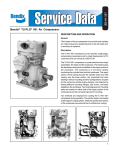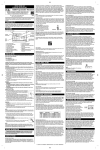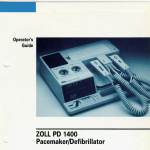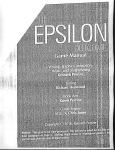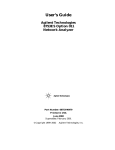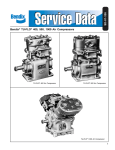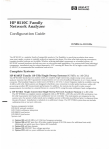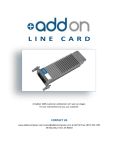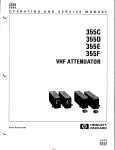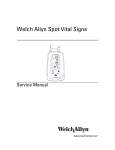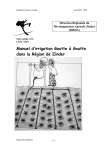Download HP 85062A 3.5 mm Electronic Calibration Kit
Transcript
Errata Title & Document Type: 85062A 3.5 mm Electronic Calibration K Operating and Service Manual Manual Part Number: 85062-90001 Revision Date: 1995-01-01 HP References in this Manual This manual may contain references to HP or Hewlett-Packard. Please note that HewlettPackard's former test and measurement, semiconductor products and chemical analysis businesses are now part of Agilent Technologies. We have made no changes to this manual copy. The HP XXXX referred to in this document is now the Agilent XXXX. For example, model number HP8648A is now model number Agilent 8648A. About this Manual We’ve added this manual to the Agilent website in an effort to help you support your product. This manual provides the best information we could find. It may be incomplete or contain dated information, and the scan quality may not be ideal. If we find a better copy in the future, we will add it to the Agilent website. Support for Your Product Agilent no longer sells or supports this product. You will find any other available product information on the Agilent Test & Measurement website: www.tm.agilent.com Search for the model number of this product, and the resulting product page will guide you to any available information. Our service centers may be able to perform calibration if no repair parts are needed, but no other support from Agilent is available. HP 85062A 3.5 mm Electronic Calibration Kit Operating and Service Manual SERIAL NUMBERS This manual applies directly to any HP 85062A Calibration Kit having serial prefix US3444 and above. HEWLETT PACKARD 85062-90001 HP Part Number: 1995 Printed in USA First Edition 0 Copyright 1995 Hewlett-Packard Company CERTIFICATION Hewlett-Packard Company certifies that this product met its published specifications at the time of shipment from the factory. Hewlett-Packard further certifies that its calibration measurements are traceable to the United States National Institute of Standards and Technology (NIST, formerly NBS), to the extent allowed by the institutes calibration facility, and to the calibration facilities of other International Standards Organization members. WARRANTY This Hewlett-Packard instrument product is warranted against defects in material and workmanship for a period of one year from date of delivery. During the warranty period, Hewlett-Packard will, at its option, either repair or replace products which prove to be defective. For warranty service or repair, this product must be returned to a service facility designated by HP. Buyer shall prepay shipping charges to HP and HP shall pay all shipping charges to return the product to Buyer. However, Buyer shall pay all shipping charges, duties, and taxes for products returned to HP from another country. HP warrants that its software and firmware designated by HP for use with an instrument will execute its programming instructions when properly installed on that instrument. HP does not warrant that the operation of the instrument, or software, or firmware will be uninterrupted or error free. LIMITATION OF WARRANTY The foregoing warranty shall not apply to defects resultin,0 from improper maintenance by Buyer, Buyer-supplied software or interfacing, unauthorized modification or misuse, operation outside of the environmental specifications for the product, or improper site preparation or maintenance. NO OTHER WARRANT Y IS EXPRESSED OR IMPLIED. HP SPECIFICALLY DISCLAIMS THE IMPLIED WARRANTIE S OR MERCHANTABILITY AND FITNESS FOR A PARTICULAR PURPOSE. EXCLUSIVE REMEDIES THE REMEDIES PROVIDED HEREIN ARE BUYER’S SOLE AND EXCLUSIVE REMEDIES. HP SHALL NOT BE LIABLE FOR ANY DIRECT, INDIRECT, SPECIAL, INCIDENTAL, OR CONSEQUENTIAL DAMAGES, WHETHER BASED ON CONTRACT, TORT, OR ANY OTHER LEGAL THEORY. ASSISTANCE Product maintenance agreements and other customer assistance agreements are available for HewlettPackard Products. For any assistance, contact your nearest Hewlett-Packard Sales and Service Office. Addresses are provided at the back of this manual. I Chapter 1 General Information CALIBRATIONKITOVERVIEW ............................................ ..~...l- 1 AvailableOptions ........................................................... ..l- 1 EQUIPMENT REQUIRED BUT NOT SUPPLIED ..................................... .1-l SERIALNUMBERS.. .......................................................... ..l- 2 INCOMING INSPECTION ......................................................... l-3 PREVENTIVEMAINTENANCE ................................................. ..l- 3 Chapter 2 Specifications and Characteristics SPECIFICATIONS TERMINOLOGY ............................................... .2- 1 Definitions ................................................. ..~...............2- 1 References to Connector Sex .................................................... .2- 1 ENVIRONMENTAL SPECIFICATIONS ............................................ -2-2 Operating Temperature and Accuracy Enhancement ................................. -2-2 Barometric Pressure and Relative Humidity ........................................ .2-3 MECHANICAL CHARACTERISTICS .............................................. -2-3 Center Conductor Protrusion and Pin Depth ........................................ .2-3 ConnectorTorque ........................................................... ..2- 4 SUPPLEMENTAL CHARACTERISTICS ............................................ -2-4 Chapter 3 User Information THE CALIBRATION DEVICES AND THEIR USE .................................... .3-l Design, Construction, and Functionality ........................................... .3- 1 CALIBRATIONCONSTANTS ................................................... ..3- 1 PERFORMINGCALIBRATIONS ................................................. ..3- 1 CHANGING THE CALIBRATION DATA ........................................... -3-l Chapter 4 Preparation For Use - Gaging and Making Connections OPERATINGPRECAUTIONS ............................................. Handling and Storage ................................................... Electrostatic Discharge ................................................. VISUALINSPECTION ................................................... Obvious Defects or Damage ............................................. Mating Plane Surfaces .................................................. ConnectorWear ....................................................... CLEANINGCONNECTORS ............................................... Periodically Check for Alcohol Contamination ............................... GENERAL CLEANING PROCEDURES ..................................... GAGING DEVICES IN THIS KIT ........................................... Gage intent ........................................................... HP 8506ZA _...... 4-l . . . . . . . 4-l ..-.... 4-l .._.... 4-2 . . . . . . . 4-2 ._._... 4-2 . . . . . . . 4-2 . . . . . . . 4-3 . . . _ . . . 4-3 . . . . . . . 4-3 . . . . . . . 4-4 . . . . . . . 4-4 Contents-l GageAccuracy................................................................4- 4 When to Gage Connectors ...................................................... .4-4 .4-5 CONNECTOR GAGES ........................................................... Types ............. ..-.......................................................4- 5 ZEROING THE CONNECTOR GAGE .............................................. .4-6 GAGING TECHNIQUES ......................................................... .4-7 Male 3.5 mm (Push-on Type Gage). .............................................. -4-7 Male 3.5 mm (Screw-on Type Gage) ............................................. .4-9 Female 3.5 mm (Push-on Type Gage) ............................................. .4- 10 Female 3.5 mm (Screw-on Type Gage) ............................................ -4-11 MAKING CONNECTIONS ....................................................... .4- 12 InitialConnection ........................................................... ..4-12 FinalConnection -...............................-.............................4-1 2 WEAR ............... ..--............-.........................-...........--..4-13 Chatder 5 Performance Verification WHAT RECERTIFICATION PROVIDES ............................................ .5- 1 HOWO~NTORECERTIFY.....................................-...............5- 1 WHERE TO SEND A KIT FOR RECERTIFICATION .................................. -5-2 HOW HEWLETT-PACKARD VERIFIES THE DEVICES IN THIS KIT ................... -5-2 Chapter 6 Troubleshooting RETURNINGAKITORDEVICETOHP ......................................... .-.6-l MORE INFORMATION .......................................................... .6- 1 Chapter 7 Replaceable Parts Contents-2 HP 85062A Figure l-l. Typical Calibration Kit Serial Number Label . . _ . _ . _ . _ . . . . . . . . . . _ . _ . . . . . . . . . . . .l-2 Figure 2-1. Connector Protrusion and Recession . . . _ . _ . . . . . . . . . . . . . . . . . . . . . _ _ . . . . . . . . . _ .2-3 Figure Figure Figure Figure Figure Figure 4-l. Typical 3.5 mm Connector Gage ........................................ 4-2. Gaging a 3.5 mm Male Connector Using a Push-on Type Gage ................ 4-3. Gaging a 3.5 mm Male Connector Using a Screw-on Type Gage ............... 4-4. Gaging a 3.5 mm Female Connector Using a Push-on Type Gage .............. 4-5. Gaging a 3.5 mm Female Connector Using a Screw-on Type Gage ............. 4-6. Using the Torque Wrench .............................................. . . . . . . .4-5 .4-8 .4-9 .4-10 .4-11 .4-13 Figure 6- 1. Troubleshooting Flow Diagram . . . . . . . . . . . . . . . . . . . . . . . . . . . . . . . . . . . . . . . _ . . . .6-2 Figure 7-l. HP 85062A, Option 001, Replaceable Parts .................................. .7-2 Figure 7-2. HP 85062A, Option 00 1 and Option OOM, Replaceable Parts .................... .7-3 Figure 7-3. HP 85062A, Option 001 and Option OOF, Replaceable Parts ..................... .7-4 Table l- 1. Serial Numbers of Individual Calibration Devices . . . . . . . . . . . . . . - . . . . . . . . . . . . _ . . l-3 Table 2- 1. Environmental Specifications .............................................. Table 2-2.3.5 mm Connector Pin Depth Limits ........................................ Table 2-3. Electrical Characteristics ................................................. Table 2-4. Mechanical Characteristics ................................................ .2-2 .2-4 -2-4 -2-4 Table 7-l. Replaceable Parts . . . . . . . . . . . . . . . . . . . . . . . . . . . . . _ . . . . . _ . . . . . . . _ . _ . . . . . . . . . .7-l HP 85062A Contents-3 Chapter 1 General Information CALIBRATION KIT OVERVIEW The HP 85062A 3.5 mm Electronic Calibration Kit is designed to work with the HP 8506OC Electronic Calibration (ECal) Control Unit to calibrate network analyzer systems (such as the HP 85 10) for measurement of components with 3.5 mm connectors up to 26.5 GHz. See the Operating, Programming, and Service Manual for the HP 8506OC control unit for specific network analyzer models. The calibration kit consists of the following: A 1 to 26.5 GHz Calibration Module (Option 001 adds a 45 MHz to 2 GHz Calibration Module) . A Specification / Verification Program Disk An Operating and Service Manual A 5116 inch, 90 N-cm (8 in-lb) torque wrench for use on the 3.5 mm connectors A Female-to-Female Adapter (not included with Option OOF or Option OOM) A Male-to-Male Adapter (not included with Option OOF or Option OOM) This manual describes the HP 85062A Electronic Calibration Kit and provides replacement part numbers, specifications, and procedures for using, maintaining, and troubleshooting the kit. The available calibration types, the best application for each type, and the associated calibration procedures are found in the Operating, Programming, and Service Manual for the HP 8506OC control unit. l l l l l This manual assumes you know proper connector care. If not, refer to “Principles of Microwave Connector Care-Quick Reference Card”, located in the back of this manual. Refer to Chapter 7, “Replaceable Parts”, for the HP part number if another copy is needed. Note Or, contact your nearest HP sales office for the customer training course: “Understanding Connectors Used With Network Analyzers”. 43P 8505OA + 24A (on-site) 4-J.P 8505OA + 24D (at HP sales office) Available Options Option 001 adds a low band (45 MHz to 2 GHz) calibration module. Option OOM replaces the standard 3.5 mm insertable module with a non-insertable male module. Option OOF replaces the standard 3.5 mm insertable module with a non-insertable female module. Options may be combined. For example, ordering Option 001 with Option OOF would provide both a high band and a low band calibration module with non-insertable female connectors. l l l EQUIPMENT REQUIRED BUT NOT SUPPLIED Connector gage sets are required for measuring connector pin depth. Gages and various connector cleaning supplies are not provided in this kit. Refer to Chapter 7, “Replaceable Parts”, for ordering information. HP 85062A General information l-1 SERIAL NUMBERS A serial number label is attached to this calibration kit. The serial number is in the form; 0000000000. The first six digits form the serial number prefix (the first two digits are a country code, the next four are a year/ week designation). The last four digits form the suffix (a simple counting sequence). The contents of this manual apply directly to calibration kits having the serial number prefix(es) listed under SERIAL NUMBERS on the title page. A typical serial number label is shown in Figure l-l. SERIAL NUMBER f -l PREFIX SUFFIX Figure I-1. Typical Calibration Kit Serial Number Label In addition to the kit serial number, the calibration modules in the HP 85062A calibration kit are individually serialized. These serial numbers should be recorded in Table l-l when the kit is first received. The purpose of this is to help maintain the integrity of your kit. Kit integrity is one important part of compliance with U.S. MLSTD-45662A, should your compliance be required. 1-2 General Information HP 85062A ) Table I-I. Serial Numbers of Individual Calibration Devices Serialized Device Serial Number (to be recorded by user) HP 85062A 3.5 mm Electronic Calibration Kit HP 85062-6000 1 Electronic Calibration Module (low band, insertable, Option 001) HP 85062-60002 Electronic Calibration Module (high band, insertable, standard) HP 85062-60003 Electronic Calibration Module (low band, non-insertable male, Option 001 and Option OOM) HP 85062-60004 Electronic Calibration Module (high band, non-insertable male, Option OOM) HP 85062-60005 Electronic Calibration Module (low band, non-insertable female, Option 001 and Option OOF) HP 85062-60006 Electronic Calibration Module (high band, non-insertable female, Option OOF) INCOMING INSPECTION Refer to Figure 7-1, Figure 7-2, or Figure 7-3 (depending on your calibration kit options) to verify a complete shipment. Record the serial numbers of all serialized devices in your kit using Table l-l. To verify electrical performance of the devices in this kit, refer to Chapter 5, “Performance Verification.” The foamlined storage case provides protection during shipping. If the case or any device appears damaged, contact the nearest Hewlett-Packard sales and service office (see inside the back cover of this manual). HewlettPackard will arrange for repair or replacement of incomplete or damaged shipments without waiting for settlement from the transportation company. If the instrument is being returned to Hewlett-Packard for service, please include service information as described in “Returning a Kit or Device to HP” in Chapter 6, “Troubleshooting” (attach to the instrument if possible). PREVENTWE MAINTENANCE The best techniques for maintaining the integrity of the devices in this kit include routine visual inspection and cleaning, and proper gaging and connection techniques. Failure to detect and remove dirt or metallic particles on a connector mating plane surface can degrade repeatability and accuracy and can damage any connector mated to it. Improper connections resulting from pin depth values being out of the observed limits (see Table 2-2) or from using poor connection techniques can also damage these devices. Visual inspection, cleaning and connection techniques, and proper gaging for pin depth are all described in Chapter 4, “Preparation for Use - Gaging and Making Connections.” HP 85062A General Information l-3 Chapter 2 Specifications and Characteristics SPECIFICATIONS TERMINOLOGY Definitions The definitions explained here help to clarify the terms used in the remainder of this chapter. These definitions refer to the HP 85062A 3.5 mm Electronic Calibration Kit only and are not necessarily valid definitions for other HP products. Operating Temperature Range. This is the temperature range over which the calibration standards maintain performance to their specifications. Accuracy-Enhanced Temperature Range. This is the allowable network analyzer ambient temperature drift during measurement calibration and during measurements when the network analyzer correction is turned on. It is also the range over which the network analyzer maintains its specified performance while correction is turned on. If this temperature range is exceeded, the accuracy-enhanced performance of the network analyzer will be degraded. Measurement Calibration. This is the calibration performed to determine the corrections necessary for accuracy-enhanced (correction on) measurements. Connector Pin Depth VaZues. Refer to Figure 2-l and Table 2-2. Pin depth is a relative measurement between the center conductor and outer conductor mating surfaces. All references to pin depth in this manual treat positive (+) values as protrusions, and negative (-) values as recessions. References to Connector Sex In this manual, adapters, calibration modules, and gage masters are referred to by the sex of their connector. For example, a male adapter has a male connector. A gage is referred to by the sex of the connector that it measures. For example, a male gage measures male connectors; a male gage has a female connector. HP 85062A Specifications and Characteristics 2-1 ENVIRONMENTAL SPEClFlCATlONS Table 2-l lists the environmental specifications for the modules in the HP 85062 Calibration Kit. Table 2-1. Environmental Speci$ications Specifications Limits Operating Temperature Range +20 to +26 “C (+68 to +79 o F) Error-Corrected Temperature Range *l “C of measurement calibration temperature Storage Temperature -40 to +75 “C (-40 to +167 OF) Barometric Pressure (Altitude) Operation Storage <4,500 meters (15,000 feet) <15,000 meters (50,000 feet) Relative Humidity Operation Storage Non-condensing at all times 0 to 80% (26 “C maximum dry bulb) 0 to 95% / EM1 i Conducted Susceptibility Radiated Susceptibility Radiated Emissions Magnetic Emissions CETM 765 EN 50082-l/IEC 801-3 CISPRl 1 CETM 765 Operating Temperature and Accuracy Enhancement Temperature of the calibration modules is important because device dimensions (and therefore electrical characteristics) change with temperature. The temperature of the calibration devices and all connectors must be stable before use and within the operating limits shown above. A measurement calibration of the network analyzer can be made at any temperature within the operating temperature range of the calibration kit. The measurement calibration temperature of the network analyzer must be maintained within the error corrected temperature range of the network analyzer. The error corrected operating temperature range for most HP network analyzers is the initial measurement calibration temperature &l “C (21.8 “F). See the appropriate network analyzer User’s Manual. Measurement calibration, performance verification, and actual device measurements must be made within the error corrected operating temperature range specification of the network analyzer. Part of the error corrected operating temperature range can fall outside of the calibration temperature window. For example, if measurement calibration is performed at +20 “C (+68 “F), verification and measurements must be made between t-19 “C (+66.2 OF) and +21 “C (+69.8 “F). Also, if the network analyzer ambient operating temperature drift exceeds the allowable error corrected temperature range, a new measurement calibration must be performed to assure optimum accuracy. Remember that your fingers are a heat source, so avoid handling the devices unnecessarily during calibration. 2-2 Specifications and Characteristics HP 85062A Barometric Pressure and Relative Humidity Barometric pressure and relative humidity also effect device performance. Air exists between the inner and outer conductors of these devices and the dielectric constant of air varies as pressure and humidity change. Refer to Table 2-l for environmental specifications including barometric pressure. MECHANICAL CHARACTERISTICS Center Conductor Protrusion and Pin Depth Mechanical characteristics such as center conductor protrusion and pm depths are not performance specifications. They are, however, important supplemental characteristics related to electrical performance. Hewlett-Packard verifies the mechanical characteristics of the devices in this kit with special gaging processes and electrical testing. This ensures that the device connectors do not exhibit any center conductor protrusion and have proper pin depth when the kit leaves the factory. Note that center conductor protrusion or recession is referenced to the connector mating surface. Chapter 4, “Preparation for Use - Gaging and Making Connections”, explains how to use gages to determine if the kit devices have maintained their mechanical integrity (refer to Table 2-2 for typical pin depth limits). FEMALE MALE Ad OUTER CONDUCTORS CENTER CONDUCTORS OUTER CONDUCTOR MATING PLANE OUTER CONDUCTOR --j MATING PLANE Zero pm depth is when Ad = zero. A protruding center conductor is when Ad is a positive (+) value. A recessed center conductor is when Ad is a negative (-) value. Figure 2-l. Connector Protrusion and Recession HP 85062A Specifications and Characteristics 2-3 Table 2-2. 3.5 mm Connector Pin Depth Limits Device Typical Pin Depth micrometers ( 1 OA inches) Measurement Uncertainty a micrometers (1 Om4 inches) Observed Pin Depth Limits micrometers (1 OT4 inches) 3.5 mm Electronic Calibration Module -25.4 to -50.8 (-10.0 to -20.0) +1.3 to -1.3 (+0.5 to -0.5) -24.1 to -52.1 (-9.5 to -20.5) -2.5 to -13.0 (- 1 .o to -5.0) +1.3 to -1.3 (+0.5 to -0.5) -1.2 to -14.3 (-0.5 to -5.5) 3.5 mm Adapter a. Approximately +2 sigma to -2 sigma of gage uncertainty based on studies performed at the factory using gages according to recommended procedures. analog Connector Torque Torque all 3.5 mm connectors to 90 N-cm (8 in-lb). Accuracy of the torque wrench supplied in this kit is 90 N-cm *lo% (kg.0 N-cm). SUPPLEMENTAL CHARACTERISTICS Table 2-3. Electrical Characteristics Characteristic Limit Frequency Range Standard Option 001 l-26.5 GHz 0.045-2 GHz +20 dBm 1 Maximum RF Input Power I Table 2-4. Mechanical Characteristics Characteristic Limit I I Net Weight Standard Option 001 Shipping Weight Standard Option 001 1,893 grams (4.2 lbs) 2,360 grams (5.2 lbs) Dimensions (length x width x height) 350 x 200 x 67 mm (13.8 x 7.9 x 2.6 inches) 2-4 Specifications and Characteristics 1,172 grams (2.6 lbs) 1,623 grams (3.6 lbs) HP 85062A Chapter 3 User Information THE CALIBRATION DEVICES AND THEIR USE The HP 85062A 3.5 mm Electronic Calibration Kit contains a high band (1 to 26.5 GHz) electronic calibration module, Option 001 adds a low band (45 MHz to 2 GHz) electronic calibration module. Other options are described in Chapter 1. The following briefly describes the design, construction, and functionality of an electronic calibration module. Design, Construction, and Functionality Electronic calibration is achieved using a two part system consisting of an HP 8506OC Electronic Calibration Control Unit and various two-port electronic calibration modules. The control unit houses a computer with built-in firmware and controls the entire calibration process. The calibration modules are solid-state devices with programmable repeatable impedance states. These modules are characterized at HewlettPackard and are used to transfer the factory calibration accuracy to the customer. The microwave circuitry in the module uses semiconductor PIN diode switches which shunt the transmission lines to ground. The number of diodes, and their location, vary depending upon the frequency requirements. A multitude of reflection coefficients are generated by applying various combinations of the shuntsWithout shunts, the network acts as a low-loss transmission line. High isolation between the ports is obtained by driving several of the PIN diode shunts simultaneously. Control logic within the module is programmed to drive the PIN diodes to their various states. The factory measured S-parameter data of each of the various impedance states is stored inside of the module. This factory data is compared to the measured data, collected during the calibration process, and error terms are calculated. CALIBRATION CONSTANTS The HP 85062A Electronic Calibration Kit is unlike our standard mechanical calibration kits. There are no calibration constants to be loaded into the network analyzer. All of the calibration data for each individual electronic calibration module is stored within the module, and is traceable to NIST (National Institute of Standards and Technology). This calibration data is read by the HP 8506OC Electronic Calibration Control Unit each time a calibration is performed. PERFORMING CALIBRATIONS The calibration type and procedure to be used depends on the type and accuracy of measurement required for the device-under-test. The operating, programming, and service manual for the HP 8506OC Electronic Calibration Control Unit provides information regarding the available calibration types, the best application for each type, and describes the calibration procedures in detail. For information regarding specific network analyzers, refer to the appropriate network analyzer user’s manual or Hewlett-Packard application notes. CHANGING THE CALIBRATION DATA The calibration data stored in each electronic calibration module is unique to that module and can only be changed when the module is recertified or repaired. This recertification or repair can only be performed at Hewlett-Packard or at Hewlett-Packard authorized service centers. HP 85062A User Information 3-l Chapter 4 Preparation For Use - Gaging and Making Connections OPERATING PRECAUTIONS There are several precautions that must be observed to protect the devices in this kit and the instruments being used. Handling and Storage Handle and store these calibration devices with great care; their continued performance and accuracy depend on maintaining very precise mechanical tolerances of the connectors. When the calibration modules are not in use, replace their protective end caps and store them in the foam lined storage case. The storage case lid is detachable so that the case can be stored in a shallow drawer. Electrostatic Discharge CAUTION The human body almost always has some static charge. You are usually not aware of this charge because the human threshold for the perception of static discharge shock is approximately 3,000 volts. ESD as low as 60 volts can destroy sensitive microcircuits. Always wear a grounding wrist strap connected to a conductive bench mat when working near this and other sensitive equipment. When you clean or inspect connectors attached to any static sensitive circuits, either on the calibration module or on any instruments, it is essential to protect against electrostatic discharge (ESD). Static electricity builds up on the body and can easily damage sensitive internal circuit elements when discharged by contact with the center conductor of the RF connector or the center contacts of the 25 pm D-Sub connector. Always have a grounded antistatic mat in front of your test equipment and wear a grounded wrist strap attached to it. Ground yourself before you clean, inspect, or make a connection to a static-sensitive device or test port. You can, for example, grasp the grounded outer shell of the test port briefly to discharge static from your body. . . Discharge static electricity from a device before connecting it: touch the device briefly (through a resistor of at least 1 megohm) to either the outer shell of the test port connector or to another exposed ground. This discharges static electricity and protects test equipment circuitry. Refer to Chapter 7, “Replaceable Parts”, for information about ordering supplies for ESD protection. l l HP 85062A Preparation For Use - Gaging and Making Connections 4-l VISUAL INSPECTION Visual inspection and, if necessary, cleaning should be done every time a connection is made. Metal particles from the connector threads may fall into the connector when it is disconnected. One connection made with a dirty or damaged connector can damage both connectors beyond repair. In some cases, magnification is necessary to see damage on a connector. The use of a microscope with a magnification of 10x or more is recommended to detect this type of damage. Not all defects that are visible under magnification will affect the electrical performance of the connector. Use the following guidelines when evaluating the integrity of a connector. Obvious Defects or Damage Examine the connectors first for obvious defects or damage: badly worn plating, deformed threads or bent, broken, or misaligned center conductors. Connector nuts should move smoothly and be free of burrs, loose metal particles, and rough spots. Any connector that has obvious defects should be discarded or repaired before continuing. Mating Plane Surfaces between the connectors at all points on their mating plane surfaces is required for a good connection. Look especially for deep scratches or dents, and for dirt and metal particles on the connector mating plane surfaces. Also, look for bent or rounded edges on the mating plane surfaces of the center and outer conductors and for signs of damage due to excessive or uneven wear or misalignment. Light burnishing of the mating plane surface is normal, and is evident as light scratches or shallow circular marks distributed more or less uniformly over the mating plane surfaces. Other small defects and cosmetic imperfections are also normal. None of these affect electrical or mechanical performance. If a connector shows deep scratches or dents, particles clinging to the mating plane surfaces, or uneven wear, clean and inspect it again. Damaged connectors should be discarded or sent for repair. Try to determine the cause of damage before connecting a new, undamaged connector in the same configuration. Flat contact Connector Wear Connector wear eventually degrades performance. The more use a connector gets, the faster it wears and degrades. This is especially true with electrically characterized devices such as ECal modules. The wear is greatly accelerated when connectors are not kept clean. Calibration devices should have a long life if their use is on the order of a few times per week. The test port connectors on the network analyzer test set may have many connections each day, and are therefore more subject to wear. It is recommended that an adapter be used as a test port saver to minimize the wear on the test set’s test port connectors. Replace all worn connectors. 4-2 Preparation For Use - Gaging and Making Connections HP 85062A i CLEANING CONNECTORS For long, reliable connector life, carefully clean all connectors. Refer to Chapter 7, “Replaceable Parts”, for information on ordering recommended cleaning supplies. Periodically Check for Alcohol Contamination 1. Let a few drops of your cleaning alcohol evaporate on a clean glass plate or microscope slide. 2. Examine the glass in reflected light. It should be perfectly clean and free of residue. If not, do not use alcohol from that container. To keep your main supply of alcohol free from contamination, pour a small amount into a clean container and use that as your cleaning supply. Safely discard any remaining alcohol in the small container and clean the container. CAUTION If you must use a solvent, use only isopropyl alcohol. Use the least amount of alcohol possible, and avoid wetting any plastic parts in the connectors. GENERAL CLEANING PROCEDURES Warning Always use protective eyewear when using compressed air or nitrogen. This procedure assumes you have taken the necessary ESD precautions. 1. wed Air or m. Use compressed air or nitrogen to loosen particles on the connector mating plane surfaces. Clean air cannot damage a connector, or leave particles or residues behind. You can use any source of clean, dry, low-pressure compressed air or nitrogen that has an effective oilvapor filter and liquid condensation trap placed just before the outlet hose. Ground the hose nozzle to prevent electrostatic discharge, and set the air pressure to a very low velocity; 60 psi or less. High velocity air can cause electrostatic effects when directed into a connector. 2. CleaTl. For dirt or stubborn contaminants on a connector that you cannot remove with compressed air or nitrogen, try a cleaning swab or lint-free cleaning cloth moistened with isopropyl alcohol: a. Apply a small amount of isopropyl alcohol to a cleaning swab or lint-free cleaning cloth. b. Clean the connector threads. c. Let the alcohol evaporate, then blow the threads dry with a gentle stream of clean, low- pressure compressed air or nitrogen. u Apply a small amount of isopropyl alcohol to a new 3. -suPlane. cleaning swab and clean the mating plane and interior surfaces. If the connector has a center conductor, use very short horizontal or vertical strokes (across the connector), and the least pressure possible, especially when cleaning a female connector (to avoid snagging the swab on the center conductor contact fingers). An illuminated magnifying glass helps. 4. Dry the Connector. After cleaning, blow the connector dry with a gentle stream of clean compressed air or nitrogen. Always completely dry a connector before you reassemble or use it. 5. w. Inspect the connector again under a magnifyin,0 oOlass to be sure that no particles or residues remain. HP 85062A Preparation For Use - Gaging and Making Connections 4-3 GAGING DEVICES IN THIS KIT Gage Intent Gages are intended for preventive maintenance and troubleshooting purposes only. They are effective in detecting center conductor protrusion or excessive recession and preventing connector damage on DUT’s, test accessories, and the calibration kit devices. Do not use gages for precise pin depth measurements. Note While performing pin depth measurements, use different orientations of the gage within the connector. Averaging a minimum of three readings, each taken after a quarter-turn rotation of the gage, reduces measurement variations that result from the gage or the connector face not being exactly perpendicular to the center axis. Gage Accuracy Connector gages are only capable of performing coarse measurements. They do not provide the degree of accuracy necessary to precisely measure the pin depth of the kit devices. This is partially due to the repeatability uncertainties that are associated with the measurement. Only the factory, through special gaging processes and electrical testin g, can accurately verify the mechanical characteristics of the devices. With proper technique, however, the gages are useful in detecting gross pin depth errors on device connectors. To achieve maximum accuracy, random errors must be reduced by taking the average of at least three measurements having different gage orientations on the connector. Even then, the resultant average can be in error by as much as &HMO1 inch due to systematic (biasing) errors usually resulting from worn gages and gage masters, therefore, these systematic errors were not included in the uncertainty analysis. As the gages endure more use, the systematic errors could become more significant in the accuracy of the measurement. When to Gage Connectors Gage a connector at the following times: Before you use it for the first time. It is recommended that you record the initial pin depth measurement of your device to compare with future readings. This serves as a good troubleshooting tool when you suspect damage may have occurred to the device. If either visual inspection or electrical performance suggests that the connector interface may be out of typical range (due to wear or damage, for example). If a calibration device is used by someone else or on another system or piece of equipment. As a matter of routine: initially after every 100 connections, and after that as often as experience suggests. l l l l 4-4 Preparation For Use - Gaging and Making Connections HP 85062A CONNECTOR GAGES Types Each type of connector uses a different connector gage. There are push-on type gages and screw-on type gages Every connector gage requires a gage calibration block (to zero the gage). A gage is referred to by the sex of the connector it measures. For example, a male gage measures male connectors; a male gage has a female connector. Figure 4-l shows a typical 3.5 mm connector gage. l l l BLACK RED MINUS SIGN (RECESSION) PLUS SIGN (NOT USED) LIMIT POINTER hV.ZK PLUS (PROTRUSION) SIGN . RED MINUS SIGN (NOT USED) GAGE INCREMENl 0.0001 INCH DIAL INDICATOR ’ ZERO SET KNOa GAGE SER!.AL NUMBER FEMALE 3.5 mm CONNECTOR GAGE “M:$kii$ .---EL GAGE MASTER SERLAL NUMBER Figure 4-l. Typical 3.5 mm Connector Gage HP 85062A Preparation For Use - Gaging and Making Connections 4-5 ZEROING THE CONNECTOR GAGE Note Hold a connector gage by the gage barrel, below the dial indicator. This gives the best stability, and improves measurement accuracy (cradling the gage in your hand or holding it by the dial applies stress to the gage plunger mechanism through the dial indicator housing). 1. Select the proper gage for your connector. Always use gages which are intended for 3.5 mm pin depth measurements. 2. Inspect and clean the gage: a. Inspect the connector gage and gage master carefully, exactly as you inspected the connector itself. b. Clean or replace the gage and gage master if necessary. Dirt on either the gage or the gage master makes gage measurements inaccurate, and can damage a connector. 3. Zero the connector gage: a. While holding the gage by the plunger barrel, use the connecting knurl to screw on the gage master just until you meet resistance. b. Use the torque wrench supplied with the kit to tighten the connecting nut of the gage master. c. As you watch the gage pointer , gently tap the barrel of the gage to settle the reading. The gage pointer should line up exactly with the zero mark on the gage. If not, clean and inspect both the gage and gage master. If the gage and gage master are clean and free from defects, adjust the zero set knob until the gage pointer exactly lines up with zero. Note 4-6 Check gages often to make sure that the zero setting has not changed. Generally, when the pointer on a recently zeroed gage does not line up exactly with the zero mark, the gage or gage master needs cleaning. Clean both of these carefully and check the zero setting again. Preparation For Use - Gaging and Making Connections HP 85062A GAGING TECHNIQUES Male 3.5 mm (Push-on Type Gage) 1. Refer to Figure 4-2. Find the male 3.5 mm connector gage (usually marked M) which has a circular 2. 3. 4. 5. metal bushing surrounding the gage plunger. Use the protruding end of the gage calibration block (also usually marked M). Slip the calibration block into the outer bushing so that the bushing comes to rest on the outer, flat area of the calibration block. When you measure a connector, the gage outer bushing rests on the outer conductor mating plane inside the connector. Follow the instructions as described above for “Zeroing the Connector Gage.” Measure the connector: a. Carefully center and insert the gage into the male connector; the flat outer part of the gage bushing rests on the outer conductor (the male contact pin slips into the hole in the gage plunger for this purpose). b. Gently rock the connector gage within the connector to make sure the gage and the outer conductor mate flatly. c. When the gage pointer settles consistently at a reading, read the connector gage dial. HP 85062A Preparation For Use - Gaging and Making Connections 4-7 0 Use male 0 Zero gage connector using goge recessed (hos circular end of insert gage into connector. Mole pin slips into gage plunger goge bushing) colibrotion 0.00s A Figure 4-2. Gaging a 3.5 mm Male Connector Using a Push-on Type Gage 4-8 Preparation For Use - Gaging and Making Connections HP 85062A Male 3.5 mm (Screw-on Type Gage) 1. Refer to Figure 4-3. 2. Follow the instructions as described above for “Zeroing the Connector Gage.” 3. While holding the gage by the barrel, screw on the connector of the calibration module to be measured. Without turning the gage or calibration module, connect the nut finger-tight. 4. Torque the connector onto the gage to 90 N-cm (8 in-lb) using the supplied 5/l 6 in. torque wrench or equivalent. 5. Gently tap the barrel of the gage with your finger to settle the reading. 6. Read the gage indicator dial. 7. For maximum accuracy, measure the connector a minimum of three times and take an average of the readings. 0 Use screw-on mole 0 Zero gage using 0 Screw the device connector calibration onto the gage block gags. Connecting nut. Tap the device to gage. Read recession or protrusion Torque settle from the the the gage. Figure 4-3. Gaging a 3.5 mm Male Connector Using a Screw-on Type Gage HP 85062A Preparation For Use - Gaging and Making Connections 4-9 Female 3.5 mm (Push-on Type Gage) 1. Refer to Figure 4-4. Find the female 3.5 mm connector gage (usually marked F). 2. Using the flat end of the gage calibration block (also usually marked F), follow the instructions as described above for “Zeroing the Connector Gage.” 3. Measure the connector: a. Carefully center and insert the gage into the connector; the gage plunger rests on the outer end of the female contact fingersb. Gently rock the connector gage within the connector to make sure the gage and the outer conductor mate flatly. c. When the gage pointer settles consistently at a reading, read the gage indicator dial. 0 l 0 use femole Zero gage connector gcge using end fiat (has of Insert gag* into connector. Plunger rests on fiat end of no goge circular bushing) calibration block female contatc fingers. 0.OO.h Figure 4-4. Gaging a 3.5 mm Female Connector Using a Push-on Type Gage 4-10 Preparation For Use - Gaging and Making Connections HP 85062A Female 3.5 mm (Screw-on Type Gage) 1. Refer to Figure 4-5. 2. Follow the instructions as described above for “Zeroing the Connector Gage-” 3. While holding the gage by the barrel, screw on the connector of the calibration module to be measured. Without turning the gage or calibration module, connect the nut finger-tight. 4. Torque the connector onto the gage to 90 N-cm (8 in-lb) using the supplied 5/16 in. torque wrench or equivalent. 5. Gently tap the barrel of the gage with your finger to settle the reading. 6. Read the gage indicator dial. 7. For maximum accuracy, measure the connector a minimum of three times and take an average of the readings. 0 Use 0 Zero Screw screw-an femoie connector goge using cotibratian the device onto the gogt black Torque the connecting nut. Tap the device to aettle gage. Reod recession or protrusion from gage. the the gage. Figure 4-5. Gaging a 3.5 mm Female Connector Using a Screw-on Type Gage HP 85062A Preparation For Use - Gaging and Making Connections 4-l 1 MAKING CONNECTIONS Good connections require a skilled operator. Because of instrument sensitivity and coaxial connector mechanical tolerances, slight errors in operator technique can significantly affect measurements and measurement uncertainties. Initial Connection CAUTION This procedure assumes that you have taken the necessary ESD precautions, and you have already cleaned and inspected (visually and mechanically) the connectors. 1. Carefully align the connectors. As you bring one connector up to the other, and as you make the actual connection, be sure the connectors align perfectly. The male connector center pin must slip concentrically into the contact fingers of the female connector. If not, stop and begin again. 2. Push the connectors straight together. Do not twist or screw them together. As the center conductors mate, you may feel a slight resistance. 3. Engage the connector nut over the threads on the second connector. Turn only the connector nut. Let the connector nut pull the two connectors straight together. Final Connection CAUTION When making connections with the calibration modules, turn the nut on the connector, never turn the module itself. Doing so may cause damage to the module or to the attaching connector. 1. Hand tighten the connection to be torqued. 2. Hold the torque wrench with your thumb and index finger behind the groove in the handle. 3. Tighten the connection until the handle begins to break loose. It is not necessary to fully break the handle of the torque wrench to reach the specified torque (Figure 4-6). Note When making connections with these devices, use an open end wrench to hold one device stationary while torquing the nut on the other device/cable connector. Also, remember that the setting of the torque wrench can change with use. Re-calibrate at a schedule appropriate to the amount of use. 4. Reverse the order to disconnect the connection. 4-12 Preparation For Use - Gaging and Making Connections HP 85062A HANDLE BEGINS TO BREAK (CORRECT POINT TO STOP) HOLD HERE HANDLE FULLY BROKEN (NOT RECOMMENDED) . .. . ..-_.. .’ TORQUEING DIRECTION Figure 4-6. Using the Torque Wrench HP 85062A Preparation For Use - Gaging and Making Connections 4-l 3 Chapter 5 Performance Verification The performance of your calibration kit can only be verified by returning the kit to Hewlett-Packard or at Hewlett-Packard authorized service centers. The equipment and calibration standards required to verify the specification limits of the devices internal to the kit have been specially manufactured and are not commercially available. Hewlett-Packard recognizes its responsibility to provide you with procedures to reconfirm the published specifications of any product offered. That commitment applies equally to the HP 85062A 3.5 mm Electronic Calibration Kit. If it is imperative that the performance test processes for this kit be explained or made available to you, contact the nearest Hewlett-Packard sales and service office listed inside the back cover of this manual. WHAT RECERTIFICATION PROVIDES The following will be provided with a recertified kit: New calibration sticker affixed to the case Certificate of Calibration List of NIST (United States National Institute of Standards and Technology) traceable numbers A calibration report for each traceable device in the kit listing values, specifications, and uncertainties A new set of S-Parameter data (embedded in module memory) The following is available on request: IvIlL-STD-45662A or equivalent certification For more information, contact the nearest Hewlett-Packard sales and service office listed inside the back cover of this manual. l l l l l l HOW OFTEN TO RECERTIFY The suggested initial interval for recertification is 12 months or sooner. The actual need for recertification depends on use of the kit. After reviewing the results of the initial recertification, you may establish a different recertification interval that reflects the usage and wear of the kit. Note HP 85062A In some cases, a kit may be not used for some time after the actual recertification date. The recertification interval should begin on the date the kit is first used. Performance Verification 5-l WHERE TO SEND A KIT FOR RECERTIFICATION Contact the nearest Hewlett-Packard sales and service office listed inside the back cover of this manual for information on where to send your kit for recertification. When you return the kit, please include service information as described in “Returning a Kit or Device to HP” in Section 6, “Troubleshooting” (attach to the instrument if possible). HOW HEWLETT-PACKARD VERIFIES THE DEVICES IN THIS KIT Hewlett-Packard verifies the specifications of these devices as follows: The residual microwave error terms of the test system are verified with precision airlines and shorts, or low frequency resistance. The resistance is traceable to NIST (United States National Institute of Standards and Technology). The airline and short characteristics are developed from mechanical measurements. The mechanical measurements and material properties are carefully modeled to give a very accurate electrical representation. The mechanical measurements are traceable to NIST through various plug and ring gages and other mechanical measurements. Each calibration device is electrically tested on this test system to the specifications listed in this manual. These two steps establish a traceable link to NIST for Hewlett-Packard to the extent allowed by the Institute’s calibration facility. The devices in this kit are traceable to NIST through Hewlett-Packard. 5-2 Performance Verification HP 85062A 1 Chapter 6 Troubleshooting If you suspect a bad calibration, or if your network analyzer does not pass performance verification, follow the steps in Figure 6- 1. RETURNING A KIT OR DEVICE TO HP If your calibration kit or device requires service, contact the HP office nearest you for information on where to send it (sales and service offices are listed inside the back cover of this manual). If the instrument is being returned to HP for service, please include the following service information (attach to the instrument if possible): a. Company Name b. Company Address c. Technical Contact Person d. Telephone Number and Extension e. Model Number f. Serial Number g. Purchase Order Number h. Date i. Accessories Returned With Instrument j. Type of Service Required. Please describe the problem(s) as specifically as possible. k. Any Other Applicable Information. MORE INFORMATION This manual contains limited information about network analyzer system operation. For complete information, refer to the instrument documentation. If you need additional information, contact your local Hewlett-Packard representatives. Sales and service offices are listed inside the back cover of this manual. HP 85062A Troubleshooting 6-1 I RECALIBRATE SYSTEM - ALL CONNECTIONS l PROPERLY MADE? TORQUE DRIICES: 3.5 mm TO 90 N-an (8 in-lb) FINISH SMDOTH B REPAIR OR RECERTIN MODULE(S) RETURN MODULE(S) TO HP FOR CONNEiT&i REPAIR OR REPLACEMENT t-i b I Figure 6-l. Troubleshooting Flow Diagram 6-2 Troubleshooting HP 85062A Chapter 7 Replaceable Parts Table 7-l lists the replacement part numbers for the contents of the HP 85062A calibration kit and for or.her parts which are not included in the kit. To order a listed part, note the description, HP part number, and the quantity desired. Telephone or send your order to the HP office nearest you (sales and service offices are listed inside the back cover of this manual). Table 7-1. Replaceable Pans DESCRIPTION Qn HP PART NUMBER High Band Calibration Modules Insertable (Standard) Non-Insertable Male (Option OOM) Non-Insertable Female (Option OOF) 1 1 1 85062-60002 85062-60004 85062-60006 Low Band Calibration Modules Insertable (Option 001) Non-Insertable Male (Option 001 and Option OOM) Non-Insertable Female (Option 001 and Option OOF) 1 1 1 85062-60001 85062-60003 85062-60005 Adapter? 3.5 mm Female-to-Female Adapter 3.5 mm Male-to-Male Adapter 1 1 85052-60012 85052-60014 Protective End Caps DB-25 Multi-pin Connector 3.5 mm Female Connector 3.5 mm Male Connector Cleaning Supplies Compressed Air 99.5% Isopropyl Alcohol (8 oz.) 99.5% Isopropyl Alcohol (30 ml) Cleaning Swabs Alcohol Wipes Lint-free Cleaning Cloth ESD Supplies Grounding Wrist Strap 5 ft. Wrist-strap to Table-mat Grounding Cord 2 x 4 ft. Conductive Table Mat with 15 ft. Ground Wire ESD Heel Strap Hard-surface Conductive Floor Mat 4 x 5 ft. 3 x4ft. Soft Surface Conductive Floor Mat (4 x 8 ft.) Other Speciiication I Verification Program Disk Operating and Service Manual 5/16 in., 90 N-cm (8 in-lb) Torque Wrench Connector Care Quick Reference Card 1 per connector 1252-4690 1401-0245 1401-0246 1 8 oz. 3oml 100 1 box 1 8500-5262 8500-0559 8500-5344 9300-1243 92193N 9310-4242 1 1 1 1 9300-1367 9300-0980 9300-0797 9300- 1126 1 1 1 92175A 92175C 92175B 1 1 1 1 08510-10033 85062-90001 8710-1765 08510-90360 a. Not included in kit with Option OOM or OOF HP 85062A Replaceable Parts 7-1 5116 INCH TORQUE WRENCH (90 N-cm / 8 in-lb) DB-25 PROTECTIVE END CAP 3.5 mm ADAPTER (1 PER MODULE) i vtof) 3.5 mm ADAPTER &!!a (m to m) HEWLETT PACKARD 85062-60002 l-26.5 Gliz ELECTRONIC CALlBRATiON MODULE Ifi HEWLETT PACKARD 45 MHz-2 GHz ELECTRONIC CALIBRATION MODULE IZIID CAUllON: +20 dBm MAX AVOID STATIC DISCHARGE / 85062-50001 / 3.5 mm MALE OR FEMALE PROTECTIVE END CAPS (ONE PER CONNECTOR) 1 1 / PORT A 1 / PORT B j I I Ii IA! I I I CAUTION: i20 dBm MAX AVOID 5TATlC DISCHARGE I - IIi, Not shown: Operating and Service Manual, Storage Case, Specification / Verification Program Disk. Notes: Low band module shown is included only with Option 001. Serial numbers are located on opposite side of modules. Figure 7-1. HP 85062A, Option 001, Replaceable Parts 7-2 Replaceable Parts HP 85062A 5116 INCH TORQUE WRENCH (90 N-cm I8 in-LB) DB-25 PROTECTIVE END CAP (1 PER MODULE) r1’ I / I HEWLETT PACKARD \’ \ \ 85062-60004 l-26.5 GH2 ELECTRONIC CALlBRATlON MODULE ,I \ I I HEWLETT PACKARD l m 85062-60003 45 MHz-2 GHz ELECTRONIC CALIBRATION MODULE cAunoN:+2odBmMAx AVOID STATKZ DISCWRGE 3.5 mm MALE PROTECTIVE END CAPS / (ONE PER CONNECTOR) \ n! CAUTION: t20 dBm MAX AVOID STATIC DWXARGE Not shown: Operating and Service Manual, Storage Case, Specification / Verification Program Disk. Notes: Low band module shown is included only with Option 001. Serial numbers are located on opposite side of modules. Figure 7-2. HP 85062A, Option 001 and Option OOM, Replaceable Parts HP 85062A Replaceable Parts 7-3 5116 INCH TORQUE WRENCH (90 N-cm / 8 in-LB) T-------T------- (1 PER MODULE) I/ I I- DB-25 PROTECTIVE END CAP 1 HEWLETT PACKARD \ 85062-60006 l-26.5 GHi ELECTRONIC CALlBRATlON MODULE HEWLETT PACKARD 8506260005 45 MHz-2 GHz ELECTRONIC CALlBRATlON MODULE CAUTKIN: +20 dBm MAX AVOD STATIC DISCHARGE I 3.5 mm FEMALE PROTECTIVE END CAPS (ONE PER CONNECTOR) ‘A CAUTION: +20 dBm MAX AVOID STATIC DISCHARGE Not shown: Operating and Service Manual, Storage Case, Specification /Verification Program Disk. Notes: Low band module shown is included only with Option 001. Serial numbers are located on opposite side of modules. Figure 7-3. HP 85062A, Option 001 and Option OOF, Replaceable Parts 7-4 Replaceable Parts HP 85062A Principles of Microwave Connector Care-- Quick Reference Card NQTE Before You Start: Proper connector care and connection techniques are critical for accurate, repeatable measurements. Refer to the calibration kit documentation for comector care infromation. Prior to making connections to the network analyzer, carefully review the information about inspecting, cleaning, and gaging connectors. Having good connector care and connection techniques extends the life of these devices. In addition, you obtain the most accurate measurements. This type of information is typically located in Chapter 3 of the calibration kit manuals. For additional connector care instruction, contact your local Hewlett-Packard Sales and Service Office about course numbers HP 85050A+24A and HP 85050A+24D. See the reverse side of this notice for quick reference tips about connector care. HP 0851 O-90360 Printed June 1993 Principles of Microwave Connector Care-- Quick Reference Card f Do l Handling and Storage Keep connectors clean . Extend sleeve or connector nut f l f Use plastic end caps during storage Do l l l Touch mating-plane surfaces l Set connectors contact-end down / Visual Inspection Inspect all connectors carefully before every connection l l Try compressed air first l Use isopropyl alcohol l Clean connector threads - IJO l Use the correct gage type Use any abrasives l Get liquid into plastic support beads l l Use correct end of calibration block l Gage all connectors before first use Do l Align connectors carefully Make preliminary connection lightly Turn only the connector nut Use a torque wrench for final connect Do Not Use an out-of-spec connector Making Connections F Do Not l Gaging Connectors Clean and zero the gage before use l Y Use a damaged connector--ever Connector Cleaning I l l Do Not Look for metal particles, scratches, and dents Do l Do Not Do Not l Apply bending force to connection l Overighten preliminary connection l l Twist or screw any connection Tighten past torque wrench “break” point 1 : I










































